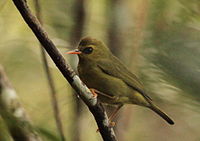
Photo from wikipedia
Aim: Our understanding of population diversification in the lowlands of Sundaland has improved substantially over the last 20 years through phylogeographical study, but we know almost nothing about population diversification… Click to show full abstract
Aim: Our understanding of population diversification in the lowlands of Sundaland has improved substantially over the last 20 years through phylogeographical study, but we know almost nothing about population diversification in the mountains of the region. Here, we apply genomic analysis and habitat modelling to the phylogeography of Chlorocharis emiliae, the Mountain Black-eye, an endemic montane bird of Borneo with a sky-island distribution, to investigate the structure and interconnectivity of its populations. In the process, we consider factors driving population diversification in the mountains versus lowlands on the island, and how population structure of C. emiliae compares with structure of previously studied lowland species. Location: Borneo. Methods: Using RAD-seq, we produced thousands of SNPs in 25 individuals from five sky-island populations of C. emiliae. These populations represent the species entire range across Borneo. Genetic structure and species tree analyses were applied to measure population relationships and connectivity. Ecological niche modelling was used to estimate habitat distributions during current and LGM time periods. Results: We identified slight to moderate genetic distinctiveness among all populations. Based on demographic models, isolation with migration was the main pattern of divergence, and the most admixture occurred among three populations in north-eastern Borneo: Kinabalu, Trus Madi and Murud. The most divergent population, Pueh, in north-western Borneo, has low genetic diversity and a small effective population size, is geographically isolated and has diverged in isolation without notable gene flow. These results, based on a large genomic dataset, contradict the evolutionary relationships identified in an earlier mitochondrial DNA study. Main conclusions: Genomic phylogeographical comparisons indicate that diversification among sky-island populations of C. emiliae was driven largely by distance and historical habitat distribution, resulting in isolation but also some inter-population gene flow. During Pleistocene glacial events, cooler temperatures would have caused montane forest to descend and spread, thereby increasing connectivity among sky-island populations. However, despite increased montane habitat, the north-western population of Pueh remained isolated. This montane pattern contrasts with phylogeographical patterns in the Bornean lowlands, where populations often display evidence of vicariance followed by secondary contact. © 2017 John Wiley & Sons Ltd.
Journal Title: Journal of Biogeography
Year Published: 2017
Link to full text (if available)
Share on Social Media: Sign Up to like & get
recommendations!